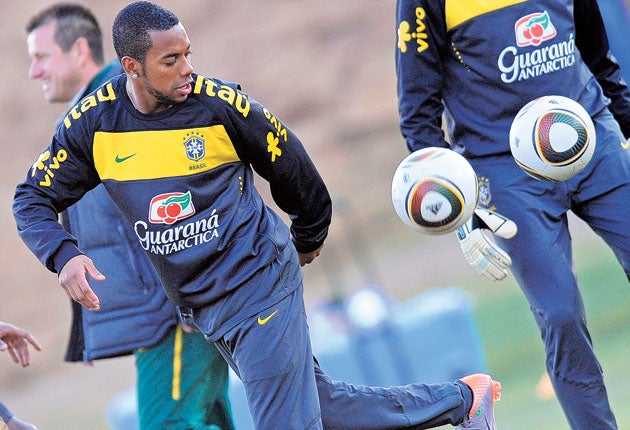The secrets of South American sides' success
As Europe’s giants struggle, their Latin rivals are in thrilling form. Glenn Moore asks why they have the advantage

The African World Cup has a South American accent. The five teams from that continent have won 81 per cent of the points available to them, winning 10 and drawing four of their 14 matches before last night's games.
Yet those from Europe, football's other established powerbase, have won 46 per cent, losing as many games (14) as they have won. Why the discrepancy? Here are some answers.
The marathon qualifying campaign
The issue is really why are Paraguay, Uruguay and Chile more successful, as no one is surprised that Brazil and Argentina have won their opening games. Uruguay were once a major football nation, too, but their last World Cup win was in 1950. Not since 1970 have they reached a quarter-final. As hosts, Chile reached the semi-final in 1962, but had not won a finals match since. Paraguay have never gone beyond the last 16.
This year they all look capable of reaching the second round and beyond. Maradona suggested this was because the South Americans have a more difficult qualifying tournament. This is a factor, but it is not just that qualifying is highly competitive. Since 1996 South American teams have had to endure a marathon round-robin between 10 teams, creating 18 fixtures each. That, said Tim Vickery, Rio de Janeiro-based correspondent for World Soccer and the BBC, has raised the standard of the smaller nations. With no qualifying required for the Copa America, the continental championship, they previously only played a handful of competitive fixtures in a good year, some years they would not play any. Now, with regular fixtures, for which European clubs have to release players under Fifa regulations, they are able to generate more income, attract better coaches, and build a team. The qualifying programme also features matches at the high altitude of Ecuador and Bolivia, so players are aware of the effects of altitude.
The 'street' players
This World Cup has highlighted the improvement in organisation of defences. The prevalence of video, and match analysis techniques, means teams prepare more thoroughly. The bigger European teams have found it hard to break down massed defences. The Spanish, Dutch and Italians passed endlessly in front of the Swiss, Japanese and Kiwi defences and only managed a goal between them, and that through a 20-yard shot by Wesley Sneijder, which swerved late. What these teams lack, argues Vickery, is a dribbler, a Lionel Messi, Alexis Sanchez or Robinho, "street footballers", who grow up, often in shanty towns, running with the ball in impromptu games.
Neil Clack, the Buenos Aires-based author of Animals! Argentina versus England, agreed. "Although you hear the same complaints about kids not playing in the streets anymore, due to lack of open spaces, computer games and schoolwork, et cetera, I still see more street football than in Britain. The spirit of the potrero [dust pitches] is still alive." European footballers, especially in the bigger, wealthy nations, develop their football in more structured environments, often in academies where passing, rather than running with the ball, is stressed. South American clubs have academies too, but Clack highlights the orientation of the coaching. "I'm currently doing the AFA [Argentine FA] coaching course. Three evenings a week, three hours per evening, for two years [far more than the English equivalent]. All the emphasis is upon developing skills and technique between the ages of 7 and 14; reduced football, small spaces, small goals et cetera. Every drill is about developing technique."
The most South American-orientated European team is Portugal, with their trio of Brazilian players. While negated by the Ivory Coast they opened up North Korea without too much difficulty.
The Jabulani ball
European teams tend to play the ball in the air more. The Jabulani appears harder to control once off the ground, with crosses and long passes constantly over-hit. South American prefer a short-passing or dribbling game and appear to have been less handicapped.
An attacking outlook
European teams, increasingly influenced by the Champions League, often look to score on "transitions", or counter-attacks. This does not work against massed defences. The South Americans have been more positive. Maradona loves his Argentina team "because they attack". Dunga's Brazil, though regarded in many quarters as a functional betrayal of their heritage, have Maicon and Michel Bastos raiding forward from full-back. Paraguay's Gerardo Martinez criticised his players for sitting back after taking the lead against Slovakia. The coach won his first match, against Colombia, 5-0 but moaned because it had been a counter-attacking victory.
Fitness
The days when Europeans would overwhelm South Americans physically are largely over. The Europeans still have a height advantage, but the global development of sports science means they are no longer fitter.
Migration
The increasing migration of footballers has opened up first-team places for promising youngsters in South America as players head for Europe. Conversely, in England, Germany, Italy and Spain, first teams are filled with foreigners .
Argentinian coaches
Argentina, Paraguay and Chile are all coached by Argentines. Maybe England should follow suit?
Join our commenting forum
Join thought-provoking conversations, follow other Independent readers and see their replies
Comments